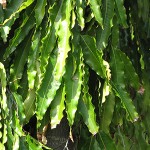Species: Polyalthia longifolia
English Name: Weeping Polyalthia
Chinese Name: 垂枝暗羅
Family: Annonaceae
Description:
Trees to 20 m tall; trunk straight. Branches finely striate, minutely puberulent when young, soon glabrous. Petiole 5-10 mm; leaf blade ovate-oblong to ovate-lanceolate, 11-31 × 2.5-8 cm, stiffly membranous to thinly leathery, glabrous, abaxially pale, adaxially dark glossy green, secondary veins 18-24 on each side of midvein, reticulate veins raised on both surfaces, base cuneate, obtuse, or rounded, margin undulate, apex acuminate. Inflorescences axillary, fasciculate and shortly pedunculate, racemose, or umbelliform and sessile, mostly many flowered; peduncle to 0.7-1.5 cm; rachis to 1 cm. Pedicel 2-4 cm; bracteole usually 1, at middle of petiole, to 1 mm, tomentulose. Sepals ovate-triangular, 1.5-3 × 1.5-1.8 mm, outside tomentulose, inside glabrous. Petals greenish yellow, narrowly triangular-lanceolate, 1.3-1.5 × 0.2-0.4 cm, subequal, spreading, inside puberulent except basally, base broad, apex acute. Stamens 8-10 cm; connectives apically convex. Carpels 20-25, ca. 1.5 mm, apex tomentulose; ovule 1 per carpel; stigmas sessile, rectangular to oblong, pubescent, with a groove on inner side and continuing down inner side of ovary. Monocarp stipes 1-2 cm; monocarps 4-8, purple, ovoid, 2-2.5 × ca. 1.5 cm, glabrous. Seed pale brown, ovoid, ca. 2 × 1.4 cm, usually with a longitudinal groove. Fl. May-Jun, fr. Jul-Sep. 2n = 18.

Photos used under a Creative Commons license
References:
Wu ZY, Raven PH, Hong DY (eds) (2011) Flora of China. Vol. 19 (Cucurbitaceae through Valerianaceae, with Annonaceae and Berberidaceae). Science Press, Beijing, and Missouri Bot Garden Press, St. Louis

